| Listing 1 - 10 of 24 | << page >> |
Sort by
|
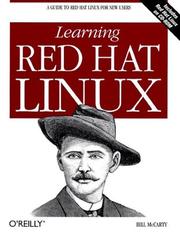
ISBN: 1565926277 Year: 1999 Publisher: Beijing : O'Reilly,
Abstract | Keywords | Export | Availability | Bookmark
 Loading...
Loading...Choose an application
- Reference Manager
- EndNote
- RefWorks (Direct export to RefWorks)
681.3.066 --- Besturingssystemen --- Linux --- Operating systems (Computers) --- Linux. --- Operating systems (Computers). --- Computer operating systems --- Computers --- Disk operating systems --- Systems software --- Operating systems --- Slackware Linux --- SUSE Linux
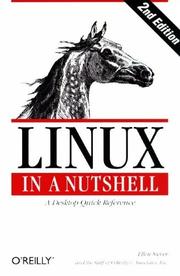
ISBN: 1565925858 Year: 1999 Publisher: Cambridge ; Sebastopol, CA : O'Reilly,
Abstract | Keywords | Export | Availability | Bookmark
 Loading...
Loading...Choose an application
- Reference Manager
- EndNote
- RefWorks (Direct export to RefWorks)
Programming --- Operating systems (Computers) --- Systèmes d'exploitation (Ordinateurs) --- Linux. --- 681.3.066 --- Besturingssystemen --- Linux --- Operating systems (Computers). --- Systèmes d'exploitation (Ordinateurs) --- Computer operating systems --- Computers --- Disk operating systems --- Systems software --- Operating systems --- Slackware Linux --- SUSE Linux
Book
ISBN: 3642586279 Year: 1999 Publisher: Berlin, Heidelberg : Springer Berlin Heidelberg : Imprint: Springer,
Abstract | Keywords | Export | Availability | Bookmark
 Loading...
Loading...Choose an application
- Reference Manager
- EndNote
- RefWorks (Direct export to RefWorks)
Approaches to project scheduling under resource constraints are discussed in this book. After an overview of different models, it deals with exact and heuristic scheduling algorithms. The focus is on the development of new algorithms. Computational experiments demonstrate the efficiency of the new heuristics. Finally, it is shown how the models and methods discussed here can be applied to projects in research and development as well as market research.
Operations research. --- Decision making. --- Production management. --- Operating systems (Computers). --- Operations Research/Decision Theory. --- Operations Management. --- Operating Systems. --- Computer operating systems --- Computers --- Disk operating systems --- Systems software --- Manufacturing management --- Industrial management --- Deciding --- Decision (Psychology) --- Decision analysis --- Decision processes --- Making decisions --- Management --- Management decisions --- Choice (Psychology) --- Problem solving --- Operational analysis --- Operational research --- Industrial engineering --- Management science --- Research --- System theory --- Operating systems --- Decision making

ISBN: 0201183935 Year: 1999 Publisher: Reading (Mass.): Addison-Wesley
Abstract | Keywords | Export | Availability | Bookmark
 Loading...
Loading...Choose an application
- Reference Manager
- EndNote
- RefWorks (Direct export to RefWorks)
Programming --- Computer architecture. Operating systems --- Operating systems (Computers) --- Java (Computer program language) --- Systèmes d'exploitation (Ordinateurs) --- Java (Langage de programmation) --- JavaOS. --- 681.3*C24 --- 681.3*D4 --- Distributed systems: distributed databases; distributed applications; networkoperating systems --- Operating systems--See also {681.3*C} --- 681.3*D4 Operating systems--See also {681.3*C} --- 681.3*C24 Distributed systems: distributed databases; distributed applications; networkoperating systems --- Systèmes d'exploitation (Ordinateurs) --- Computer operating systems --- Computers --- Disk operating systems --- Systems software --- Object-oriented programming languages --- JavaSpaces technology --- Operating systems --- Java operating system
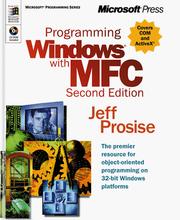
ISBN: 1572316950 9781572316959 Year: 1999 Publisher: Redmond : Microsoft,
Abstract | Keywords | Export | Availability | Bookmark
 Loading...
Loading...Choose an application
- Reference Manager
- EndNote
- RefWorks (Direct export to RefWorks)
Operating systems (Computers) --- AA / International- internationaal --- 654 --- Informatieverwerking. Bureautica. --- Programmeren --- Windows --- Programmeren. --- Windows. --- Computer operating systems --- Computers --- Disk operating systems --- Informatieverwerking. Bureautica --- Operating systems --- Microsoft foundation class library. --- Microsoft Windows (Computer file) --- Windows (Computer file) --- Chicago (Computer file) --- Microsoft Windows 95 --- Windows 95 --- Microsoft Windows CE --- Windows CE --- Pegasus (Computer file) --- Windows for workgroups --- Microsoft Windows for workgroups --- Windows 98 --- Microsoft Windows 98 --- Windows 2000 professional --- Windows 2000 --- Microsoft Windows 2000 --- Microsoft Windows Me millennium edition --- Windows Me --- Microsoft Windows XP (Computer file) --- Windows XP --- Microsoft Windows Vista --- Windows Vista --- Microsoft Windows 7 --- Windows 7 --- Windows 8 --- Windows 10 --- MFC (Computer file) --- Systems software

ISBN: 0306460653 9786610205080 1280205083 0306469685 Year: 1999 Publisher: New York, New York : Kluwer Academic Publishers,
Abstract | Keywords | Export | Availability | Bookmark
 Loading...
Loading...Choose an application
- Reference Manager
- EndNote
- RefWorks (Direct export to RefWorks)
This book provides an overview of the X Window System focusing on characteristics that have significant impact on the development of both application programs and widgets. We pay special attention to applications that go beyond graphical user interfaces (GUIs); therefore we discuss issues affecting video games, visualization and imaging programs, and designing widgets with a complex appearance. While the book does not assume previous knowledge of X, it is intended for experienced programmers, especially those who want to write programs that go beyond simple GUIs. X is the dominant window system under Unix, and X servers are available for Microsoft Windows, thus enabling graphics over a network in the PC world. While Java offers an apparently universal graphics library (the abstract window toolkit), the reality is quite different: For high-quality graphics and image display, we must program on the target platform itself (X or one of Microsoft’s APIs) rather than rely on Java peer objects. X is a vast subject, so it is impossible to provide a complete coverage in a few hundred pages. Thus we selected topics that are fundamental to the system, so that the reader who masters them should be able to read the documentation of the numerous libraries and toolkits. Therefore we provide documentation on the most important Xlib and X toolkit functions only.
X Window System (Computer system) --- Graphical user interfaces (Computer systems) --- Computer programming. --- Graphical user interfaces (Computer systems). --- X Window System (Computer system). --- Computer science. --- Computer graphics. --- Operating systems (Computers). --- Programming Languages, Compilers, Interpreters. --- Computer Graphics. --- Operating Systems. --- Programming languages (Electronic computers). --- Computer operating systems --- Computers --- Disk operating systems --- Systems software --- Automatic drafting --- Graphic data processing --- Graphics, Computer --- Computer art --- Graphic arts --- Electronic data processing --- Engineering graphics --- Image processing --- Computer languages --- Computer program languages --- Computer programming languages --- Machine language --- Languages, Artificial --- Operating systems --- Digital techniques --- Electronic computer programming --- Electronic digital computers --- Programming (Electronic computers) --- Coding theory --- GUIs (Computer systems) --- User interfaces (Computer systems) --- Windows (Computer programs) --- Programming

ISBN: 1565924274 Year: 1999 Publisher: Beijing O'Reilly
Abstract | Keywords | Export | Availability | Bookmark
 Loading...
Loading...Choose an application
- Reference Manager
- EndNote
- RefWorks (Direct export to RefWorks)
681.3*D4 --- UNIX (Computer operating system) --- 681.3*D32 --- unix --- Operating systems (Computers) --- 005.432 --- Computer operating systems --- Computers --- Disk operating systems --- Systems software --- 681.3*D32 language classifications: applicative languages; data-flow languages; design languages; extensible languages; macro and assembly languages; nonprocedural languages; specialized application and very high-level languages (Programminglanguages) --- language classifications: applicative languages; data-flow languages; design languages; extensible languages; macro and assembly languages; nonprocedural languages; specialized application and very high-level languages (Programminglanguages) --- 681.3*D4 Operating systems--See also {681.3*C} --- Operating systems--See also {681.3*C} --- Operating systems --- UNIX System V (Computer file) --- Solaris (Computer file)
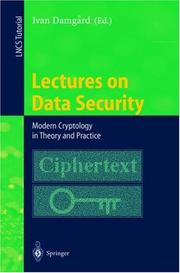
ISBN: 3540657576 354048969X Year: 1999 Volume: 1561 Publisher: Berlin ; Heidelberg : Springer,
Abstract | Keywords | Export | Availability | Bookmark
 Loading...
Loading...Choose an application
- Reference Manager
- EndNote
- RefWorks (Direct export to RefWorks)
Computer security --- Cryptography --- Sécurité informatique --- Cryptographie --- Computer Science --- Engineering & Applied Sciences --- Computer security. --- Cryptography. --- Sécurité informatique --- Cryptanalysis --- Cryptology --- Secret writing --- Steganography --- Computer privacy --- Computer system security --- Computer systems --- Computers --- Cyber security --- Cybersecurity --- Electronic digital computers --- Security of computer systems --- Security measures --- Protection of computer systems --- Protection --- Computer science. --- Computer communication systems. --- Operating systems (Computers). --- Data encryption (Computer science). --- Algorithms. --- Computer science --- Computer Science. --- Data Encryption. --- Algorithm Analysis and Problem Complexity. --- Operating Systems. --- Computer Communication Networks. --- Discrete Mathematics in Computer Science. --- Mathematics. --- Computer software. --- Computational complexity. --- Cryptology. --- Complexity, Computational --- Electronic data processing --- Machine theory --- Algorism --- Algebra --- Arithmetic --- Computer operating systems --- Disk operating systems --- Systems software --- Software, Computer --- Data encoding (Computer science) --- Encryption of data (Computer science) --- Foundations --- Operating systems --- Computer science—Mathematics. --- Communication systems, Computer --- Computer communication systems --- Data networks, Computer --- ECNs (Electronic communication networks) --- Electronic communication networks --- Networks, Computer --- Teleprocessing networks --- Data transmission systems --- Digital communications --- Electronic systems --- Information networks --- Telecommunication --- Cyberinfrastructure --- Network computers --- Distributed processing --- Operating systems (Computers) --- Informatics --- Science

ISBN: 0792384369 1461373638 1461551897 Year: 1999 Volume: [SECS 495] Publisher: Dordrecht : Kluwer,
Abstract | Keywords | Export | Availability | Bookmark
 Loading...
Loading...Choose an application
- Reference Manager
- EndNote
- RefWorks (Direct export to RefWorks)
Geographic information systems have developed rapidly in the past decade, and are now a major class of software, with applications that include infrastructure maintenance, resource management, agriculture, Earth science, and planning. But a lack of standards has led to a general inability for one GIS to interoperate with another. It is difficult for one GIS to share data with another, or for people trained on one system to adapt easily to the commands and user interface of another. Failure to interoperate is a problem at many levels, ranging from the purely technical to the semantic and the institutional. Interoperating Geographic Information Systems is about efforts to improve the ability of GISs to interoperate, and has been assembled through a collaboration between academic researchers and the software vendor community under the auspices of the US National Center for Geographic Information and Analysis and the Open GIS Consortium Inc. It includes chapters on the basic principles and the various conceptual frameworks that the research community has developed to think about the problem. Other chapters review a wide range of applications and the experiences of the authors in trying to achieve interoperability at a practical level. Interoperability opens enormous potential for new ways of using GIS and new mechanisms for exchanging data, and these are covered in chapters on information marketplaces, with special reference to geographic information. Institutional arrangements are also likely to be profoundly affected by the trend towards interoperable systems, and nowhere is the impact of interoperability more likely to cause fundamental change than in education, as educators address the needs of a new generation of GIS users with access to a new generation of tools. The book concludes with a series of chapters on education and institutional change. Interoperating Geographic Information Systems is suitable as a secondary text for graduate level courses in computer science, geography, spatial databases, and interoperability and as a reference for researchers and practitioners in industry, commerce and government.
Geographic information systems. --- Operating systems (Computers) --- Systèmes d'information géographique --- Systèmes d'exploitation (Ordinateurs) --- Systèmes d'information géographique --- Systèmes d'exploitation (Ordinateurs) --- Data structures (Computer science). --- Geographical information systems. --- Information storage and retrieval. --- Geography. --- Remote sensing. --- Data Structures and Information Theory. --- Geographical Information Systems/Cartography. --- Information Storage and Retrieval. --- Geography, general. --- Remote Sensing/Photogrammetry. --- Remote-sensing imagery --- Remote sensing systems --- Remote terrain sensing --- Sensing, Remote --- Terrain sensing, Remote --- Aerial photogrammetry --- Aerospace telemetry --- Detectors --- Space optics --- Cosmography --- Earth sciences --- World history --- Geographical information systems --- GIS (Information systems) --- Information storage and retrieval systems --- Information structures (Computer science) --- Structures, Data (Computer science) --- Structures, Information (Computer science) --- Electronic data processing --- File organization (Computer science) --- Abstract data types (Computer science) --- Geography --- Computer operating systems --- Computers --- Disk operating systems --- Systems software --- Operating systems --- Géomatique
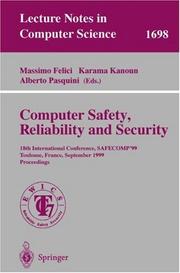
ISBN: 3540664882 9783540664888 3540482490 Year: 1999 Volume: 1698 Publisher: Berlin, Germany ; New York, New York : Springer,
Abstract | Keywords | Export | Availability | Bookmark
 Loading...
Loading...Choose an application
- Reference Manager
- EndNote
- RefWorks (Direct export to RefWorks)
The European Commission emphasizes, in its Fifth Research Framework, the “. . . emerging generic dependability requirements in the information society, stemming both from the ubiquity and volume of embedded and networked systems and services as well as from the global and complex nature of large scale information and communication infrastructures, from citizens, administrations and business in terms of technologies, tools, systems, applications and services". The series of Conference on Computer Safety, Reliability, and Security (Safecomp) contributes to satisfy these requirements by reviewing the state of the art, experiences, and new trends in the relevant scientific and industrial areas. Safecomp is intended to be a platform for technology transfer among academia, industry, and research institutions, providing the opportunity for exchange of ideas, opinions, and visions among experts. This year Safecomp celebrates the 20th anniversary, its first Conference having been organized in Stuttgart by EWICS (European Workshop on Industrial Computer Systems) in 1979, and we hope these Proceedings will contribute to the celebration by supporting Safecomp aims. The Proceedings include the 25 papers that have been presented orally at the Conference and the full version of the 14 papers that have been presented as posters, all of which were selected from 76 submissions. Papers almost uniformly take up Safecomp topics, dealing with the issues of Safety Assessment and Human Factors, Verification and Validation, Design for Safety, Formal Methods, and Security.
Computer systems --- Computer security --- Reliability --- Computer Science --- Engineering & Applied Sciences --- Computer science. --- Special purpose computers. --- Software engineering. --- Operating systems (Computers). --- Computer logic. --- Management information systems. --- Computer Science. --- Software Engineering/Programming and Operating Systems. --- Operating Systems. --- Logics and Meanings of Programs. --- Special Purpose and Application-Based Systems. --- Management of Computing and Information Systems. --- Logic design. --- Information Systems. --- Design, Logic --- Design of logic systems --- Digital electronics --- Electronic circuit design --- Logic circuits --- Machine theory --- Switching theory --- Computer operating systems --- Computers --- Disk operating systems --- Systems software --- Computer software engineering --- Engineering --- Operating systems --- Informatics --- Science --- Computer-based information systems --- EIS (Information systems) --- Executive information systems --- MIS (Information systems) --- Sociotechnical systems --- Information resources management --- Management --- Special purpose computers --- Computer science logic --- Logic, Symbolic and mathematical --- Communication systems --- Computer systems - Reliability - Congresses --- Computer security - Congresses
| Listing 1 - 10 of 24 | << page >> |
Sort by
|

 Search
Search Feedback
Feedback About
About Help
Help News
News